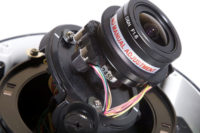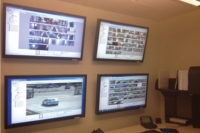When we think of applications for thermal cameras, the first one that is likely to come to mind is their ability to detect intruders in the dark.
Mike Chaffee, national thermal sales director for the Goleta, Calif.-based security division of manufacturer FLIR Systems Inc., notes for example, that thermal cameras are often used to protect utility company facilities, offering an alternative to installing bright lighting, which can cost twice as much as thermal cameras.
There are many other less obvious applications for thermal cameras as well, though.
As with conventional video cameras, thermal cameras are available in wide angle, long-range and pan-tilt-zoom configurations — and long-range thermal cameras have considerably longer range in comparison with conventional cameras. According to Tony Destefano, senior business development manager for City of Industry, Calif.-based manufacturer Hikvision USA, some thermal cameras can detect intruders over distances as great as 10 miles, and that makes them well suited for applications that can benefit from extremely long range.
Thermal cameras have benefitted greatly from advances in video analytics, which can be used to distinguish people from animals and as Keith Drummond, senior director of sales for Dallas-based manufacturer IDIS America explains, can even detect intruders approaching over a body of water.
“When you’re looking across water, it’s hard with a regular camera to [detect] anything when there are waves. But with a high-intensity thermal camera, you can see things you couldn’t see with other cameras,” explains Drummond, adding that the right thermal camera can even determine how fast the boat is going.
Dispelling Myths About Explosion-Proof Cameras
When you hear the term “explosion-proof,” you might picture a camera that keeps recording when an explosion occurs. But, as Ryan Zatolokin at Axis Communications explains, that’s not what the term means to standards bodies. Indeed, the more correct term is “explosion-protected,” he describes.
The common misperception is that explosion-protected cameras are designed to withstand an explosion when in reality “their main purpose is not to be the cause of an explosion,” says Zatolokin.
As Zatolokin explains, standards for explosion-protected installations are defined in the National Electrical Code (NEC), which is published by the National Fire Protection Association (NFPA). These standards distinguish between several sub-categories of installations, which he summarizes as follows:
- Class 1 installations must not cause an explosion in areas where gases, vapors or liquids could be flammable or ignitable. (Class 1 Division 1 pertains to explosive gases or vapors that exist under everyday operating conditions, while Class 1 Division 2 pertains to gases that are not normally present but could be.)
- Class 2 installations include areas with combustible dust such as flour from a mill, metal powders or coal dust.
- Class 3 installations pertain to fibers that could be in the air, such as at cotton seed or textile mills.
The code requirements pertain not only to cameras but also to other machinery and electronics in the specified areas, Zatolokin notes.
While not every camera manufacturer offers explosion-protected cameras, it may be possible to purchase an explosion-proof housing for cameras from those manufacturers or from a third party. Sources say those housings may come with a steep price tag, however — as much as two to three times the cost of the camera, according to Tony Destefano at Hikvision USA.
For some installations, there may be a less costly alternative, notes DeStefano. Where possible, he recommends using a less costly long-range camera that is not explosion-proof but can be positioned outside the area subject to the requirements.
The downside to thermal cameras, of course, is that they can’t be used to determine a person’s identity. But even that can be an advantage.
Ryan Zatolokin, business development manager and senior technologist for Chelmsford, Mass.-based manufacturer Axis Communications, cites the example of hospitals and other healthcare facilities that may be interested in thermal cameras to detect when, for example, a patient gets out of bed unassisted. In that situation, the facility may want to generate an alert but also may want to protect the patient’s privacy.
Some clients may want specific capabilities available from a thermal camera but also want to identify any person that the camera detects. In that case, dual-technology cameras are available that include both a thermal and a conventional camera. The conventional camera included in these devices may have infrared illumination to enable the camera to capture an image of the intruder in sufficient detail to identify the person.
Another capability available in some thermal cameras is what Zatolokin calls “thermal graphic.” As he explains, these cameras “read the temperature off objects” and can be used, for example, to detect when the equipment on an assembly line is beginning to overheat.
Thermal cameras have come down considerably in cost in recent years, sources note, making them an option for applications for which they might not have been affordable in the past.
Installation Plans
Industry experts urge security integrators to walk the area to be protected before making any decisions about a thermal camera installation.
Integrators also should consider asking the manufacturer to come along on the site visit. Several manufacturers interviewed for this article said they are very open to helping customers in that manner.
There are several basics to keep in mind when planning a thermal camera installation.
As Zatolokin notes, one concern is that thermal cameras don’t work well in areas such as southern Florida where the background temperature may be close to a person’s body temperature, reducing the camera’s ability to distinguish a human form.
It’s also important to keep in mind that applications requiring thermal cameras are likely to also require an on-site security staff or local law enforcement personnel that can respond promptly to an alarm, as the goal of many thermal camera applications is to prevent crimes from occurring in the first place.
On-Line Thermal Camera Design Tools
Several of the manufacturers we spoke with for this story offer on-line design tools for their thermal cameras. Check them out at these links:
|
Manufacturer |
URL |
|
Axis |
https://www.axis.com/en-us/products/product-selector#!/ In the drop down under “Product Characteristics” select “Thermal”. |
|
Bosch |
http://www.boschsecurity.com/LensCalculator/html/lens-calculator.html |
|
FLIR |
Selection Criteria
When it comes to selecting the specific thermal camera to use for an installation, there are three critical considerations, observes Chris Johnston, regional marketing manager for Fairpoint, N.Y.-based manufacturer Bosch Security and Safety Systems — how early do you need notification, what distance do you need to cover and what is the size of the object you want to detect?
The distance that the client needs to cover will determine the range needed, and as with conventional video cameras, range depends in large part on the lens used. But range also must be considered in combination with the size of the entity that is to be detected. Together, those criteria determine the resolution required, as well as the analytics needed.
In general, the less costly a video camera, the less resolution the camera will provide.
As Johnston explains, thermal cameras are likely to have resolution of either VGA or QVGA, with VGA cameras providing the highest resolution. VGA cameras can detect a 7.5-square foot object at a distance of almost 15,000 feet in almost any weather conditions, he explains.
One metric associated with thermal cameras that may be unfamiliar to those who have only used conventional cameras is the millikelvin, which measures the camera’s sensitivity. As Sachin Khanna, director of product development for moving cameras for Bosch, explains, millikelvins are akin to lux in traditional cameras.
The most sensitive thermal cameras have millikelvin measurements of about 40, while those with higher numbers such as 50 or 72 are less sensitive, Khanna notes.
Thermal cameras are also measured in hertz, which determine the camera’s refresh rate, making that metric roughly equivalent to the frame rate in conventional cameras.
The two most common options in thermal cameras are 9 Hz or 30 Hz, according to Khanna. While 30-Hz sensors refresh essentially in real time, 9-Hz sensors refresh more slowly. Not surprisingly, they are also less costly, just as QVGA cameras are less costly than VGA cameras. VGA 30-Hz cameras are likely to be used for the highest-security applications such as military or governmental installations.
Khanna also notes that the U.S. government closely guards 30-Hz technology out of concerns that it could be used in weapons targeting. Any dealer wanting to ship a 30-Hz thermal camera outside the U.S. will need to be prepared to describe how it will be used — and to provide documentation to back it up.
“Dealers should understand who the real end user of the product is and where the product will end up,” Johnston advises.
Analytics & Service
Security integrators should pay close attention to the analytical capabilities of any thermal camera they are buying, Drummond observes.
Some customers may want to integrate a thermal camera into an existing video analytics system. Understanding whether the camera is compliant with ONVIF standards can help determine the level of integration that will be possible, Drummond notes. Integrators serving these customers should ask, “What are the most important features and are they ONVIF compliant or already integrated into the software I’m going to use?” Drummond says.
When selling thermal camera systems, integrators should consider selling a service contract to go along with it. Drummond advises security integrators not to underestimate what they charge for service. And to help minimize the cost of providing service, he recommends that integrators include remote connectivity to the camera as part of the initial installation. Remote connectivity can be used, for example, to offload video from the SD card installed in a camera or to reboot the system if the network goes down, eliminating the need for a truck roll.
“If there is no outside communication, the maintenance cost just went up,” Drummond says.
While some customers may not want remote connectivity, Drummond encourages security integrators to push for it by, for example, offering to use a virtual private network (VPN) that can only be used for certain specific maintenance-related applications.
Clearly, thermal camera installations are complex. If there are any gray areas regarding the specific details of a thermal camera installation, integrators should consider helping the customer do a proof-of-concept test, DeStefano advises.
In recent years, thermal cameras have become more sophisticated at the same time that they have decreased in cost, making them more powerful and affordable than ever. Integrators should stay abreast of new developments in this area and keep thermal cameras in mind to address specific customer needs, such as when customers need early detection or extremely long range, when they want to protect the privacy of those who might be caught on camera, and other requirements.
More Online
Check out SDM’s previous coverage about thermal cameras at these links:
“Security Critical Infrastructure: It’s More Than Perimeter Protection,” March 2019. https://www.sdmmag.com/articles/96251-securing-critical-infrastructure-its-more-than-perimeter-protection
“Field of Dreams Movie Site Installs Video Surveillance System After Vandalism Incident,” June 2018. https://www.sdmmag.com/articles/95308-field-of-dreams-movie-site-installs-video-surveillance-system-after-vandalism-incident
“Why Thermal Cameras are Useful Video Surveillance,” March 2017. https://www.sdmmag.com/articles/93582-why-thermal-cameras-are-useful-video-surveillance
“How to Get the Most Out of Thermal Cameras,” January 2016. https://www.sdmmag.com/articles/91947-how-to-get-the-most-out-of-thermal-cameras





